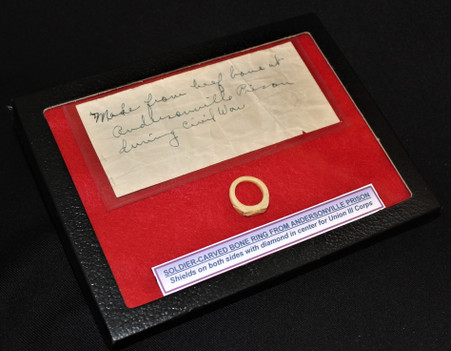 Loading... Please wait...
Loading... Please wait...-
Call us on (973) 810-2976
- My Account
- Gift Certificates
- Items / $0.00
All prices are in All prices are in USD
Categories
- Home
- Sold, Hold, Layaway items
- Very Rare – Carved Bone Ring with note from Andersonville POW Camp, III Corp (SOLD,BH)
Very Rare – Carved Bone Ring with note from Andersonville POW Camp, III Corp (SOLD,BH)
Out of Stock
Product Description
This is a rare piece being offered, it is a hand-carved bone ring, carved by a Union prisoner at the Andersonville Prison in Georgia. The ring measures just under an inch in diameter and is approximately a size 6. It has an intricately carved diamond in the center with raised shields on both sides of it. The lozenge (diamond) would be indicative of the Union Army’s III Corps, Army of the Potomac. Accompanying the ring is an old handwritten note that reads, "Made from beef bone at Andersonville Prison during Civil War".
Andersonville, or Camp Sumter as it was known officially, held more prisoners at any given time than any of the other Confederate military prisons. It was built in early 1864 after Confederate officials decided to move the large number of Federal prisoners in and around Richmond to a place of greater security and more abundant food. During the 14 months it existed, more than 45,000 Union soldiers were confined here. Of these, almost 13,000 died from disease, poor sanitation, malnutrition, overcrowding, or exposure to the elements.
Any relic from the Andersonville site is rare, the soldiers used up just about anything they could find in some way or another. In my book “The Civil War Canteen – Third Edition”, I show a very worn pewter canteen spout which was found at Andersonville. In my other book “The Civil War Soldier – His Personal Items”, I discuss and show examples of Civil War soldier carvings, which was extremely popular with soldiers to pass the time and take their minds off the fighting.
In 1865, Clara Barton visited Andersonville and while there gathered up some relics to display at the Great National Fair in Washington, DC. They were photographed by Matthew Brady and the CDV images were sold as souvenirs (see pictures). It is said that this exhibit was the most popular at the Fair.
Needless to say, this artifact is a rare and desirable POW relic, and highly sought after. There is a similar example of this ring in the Minnesota Historical Society collection, which was also recovered at Andersonville (see pictures). The ring and note come in the glass top display case pictured.



